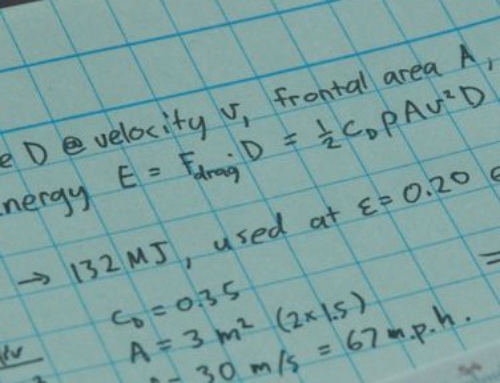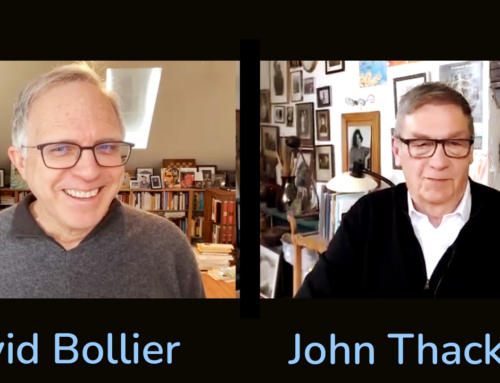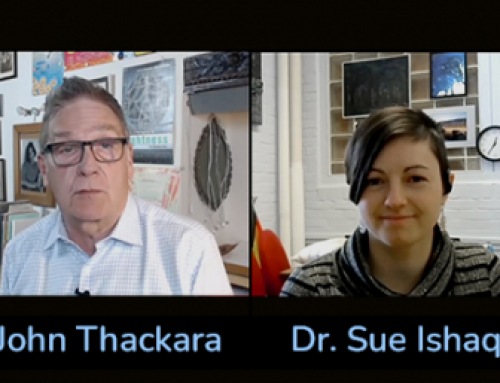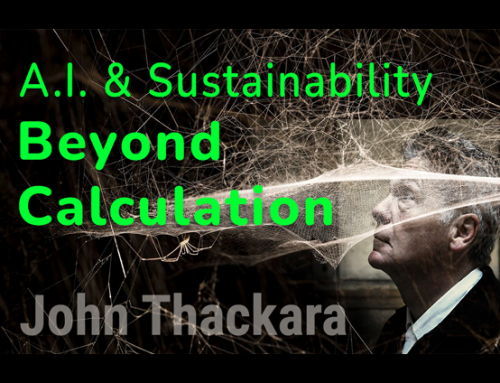What issues should the next generation of design critics write about? Where and how should they do this writing? And, how will they get paid for doing so? This is the text of my keynote talk yesterday to Crossing The Line at the School for Visual Arts in New York.
“The first question is easy. You should write about humanity’s new place in a catabolically-challenged world – and the kinds of future that await us.By catabolically-challenged I mean the complex, connected and high entropy world we’re in now – the one which can’t possibly be sustained into the indefinite future. Why? because it depends on perpetually growing throughputs of energy and resources that are not going to be available.
The True Cost campaign calls our economy a “Doomsday Machine”. We strive after infinite growth in a world whose carrying capacity is finite. The better the economy performs – faster growth, higher GDP – the faster we degrade the biosphere which is the basis of life – and our only home.
It’s madness. And the world is waking up to the fact that it’s madness.The trouble is that no society in history has ever been able to reduce its consumption of resources voluntarily over the long term.
On the contrary: as Joseph Tainter has explained: when problems in a complex society, such as our’s, emerge, tackling them requires more resources – just as resources are becoming scarcer.
Another word for this is overshoot. But it’s slow motion overshoot. Not like a mouse running off a cliff in a Disney cartoon – more like a goods wagon bumping down the unpaved side of a mountain, shedding cargo and parts along the way.
Anyone traveling in Europe two weeks ago, when the volcano blew, will know what that kind of ride feels like.
John Michael Greer, another of my muses, who first alerted us to the idea of a catbolic collapse, wrote a book called The Long Descent: A User’s Guide to the End of the Industrial Age. Greer’s account of how our high entropy society will degrade slowly and unevenly over many decades is pretty convincing. For one thing, that’s how the Maya, the Roman Empire and other civilizations declined in the past.
“The decline of a civilization is rarely anything like so sudden for those who live through it s it looks in retrospect”, writes Greer, encouragingly; it’s a much “slower and more complex transformation than the sudden catastrophes imagined by many social critics today.”
Now catabolic collapse, overshoot, and the end of civilization are too abstract to make decent stories as they stand. Besides, film makers and game designers have already made the social Armageddon space their own.
The stories that do remain to be written are about the new and better being born from the ruins of the old.
By new and better, I do not mean the happy-clappy bright-green optimism promoted in some quarters the past few years. Let’s not kid ourselves that we can pre-design a smooth transition using positive thinking and green technology.
In a new book chillingly titled ‘Requiem for a Species’, the philosopher Clive Hamilton writes that “it’s too late to avert catastrophic change. Our politics and institutions are too dysfunctional to make elegant adaptations. We’d better prepare ourselves for surviving as best we can”.
What we’re likely to experience is decades of muddling through what Greer describes as “scarcity industrialism” – a period when we liquidate what remains of the planet’s oil endowment, fossil fuels, and other nonrenewable resources.
This phase, scarcity industrialism, will morph into to a “salvage society” phase when, having depleted non-renewables, we’ll scavenge the ruins of abandoned man-made structures for their iron, steel and other raw materials.
Scarcity industrialism is well under way in India and Brazil, by the way. http://www.momentomonumento.org/en/
I’ve learned from the resource ecologies of favelas and shanty towns thyat the concept of embodied energy – emergy – stretches forwards as well as backwards in time.
Backwards, emergy measures the energy necessary for raw material extraction, transport, manufacture, assembly, installation, disassembly, deconstruction and/or decomposition. Forwards, emergy represents potential for products or componenbts to be re-purposed – without the need to mine and smelt raw materials from scratch.
And you’ll probably think I’m sad, but I can no longer look at paved surfaces without thinking about breaking them open to free the soil.
I’m describing a way of looking at the world through a fresh lens. Rather than look at the world and think about extraction and consumption, it’s about looking for ways to preserve, steward and restore assets – human and natural ones, or so-called net present assets, that already exist.
Designers have an important contribution to make. Not much, any more, as the creators of new products, buildings, and communications. New is an old paradigm.
What designers can do is cast fresh and respectful eyes on a situation to reveal material and cultural qualities that might not be obvious to those who live them.
This kind of regenerative design re-imagines the built world not as a landscape of frozen objects, but as a complex of interacting, co-dependent ecologies: energy, water, food.
Nabeel Hamdi points out that “design disturbs that which it touches…we need to give priority to the existing life and intelligence of place. There are vast latent resources in existing situations”
Hamdi, the author of “Small Change” and “Housing without Houses” is working with Habitat for Humanity on a “mind shift” – from “building shelters” to a greater appreciation for existing social and ecological assets.
What I experience, in muntiple contexts, is the re-emergence of a ethical framework.
In 1949, the American forester and ecologist Aldo Leopold proposed what he called a “land ethic” that would guide “man’s relation to land and to the animals and plants which grow upon it”. “A thing is right when it tends to preserve the integrity, stability, and beauty of the biotic community” wrote Leopold. “It is wrong, when it tends otherwise”. [“Biotic community” here is another name for what we now call the biosphere].
You may argue that this is to state the obvious: That of course you respect life, and the conditions that support life.
But I stress the word unconditional. If a commitment is unconditional, it does not mean “take account of”; or “pay due respect to”; or “move steadily towards”. It does not mean “minimise adverse effects on nature” – it means a target of *no* adverse effects.
“A thief who tells a judge he is stealing less than before will receive no leniency. So why do companies get environmental awards for polluting less — even though they are still polluting?”. The biomimicry entrepreneur Gunther Pauli, who I’m quoting here, is scornful of the “do less bad” school of environmentalism.
Pauli demands that we commit to Net Positive Impact – that’s to say, “economic activity where the demands placed upon the environment are met without reducing the capacity of the environment to provide for future generations”.
Otherwise stated: Leave the world better than you found it.
That kind of economy may sound fanciful- but it’s happening, out there, now.
Between the ‘tech-will-fix-it’ dreamers, and the ‘head-for-the-hills’ brigade, a third and much larger global movement is growing. Paul Hawken reckons it’s the single biggest movement on the planet, with a million or more active groups. But it’s been invisible in mainstream media. It’s certainly hard to spot from the lobby of the Ace Hotel here in Manhattan!
This movement is evident wherever people are growing food in cities, opening seed banks, or turning school backyards into edible gardens.
The movement includes people who are restoring ecosystems and watersheds. Their number includes dam removers, wetland restorers, and rainwater rescuers.
Many people in this movement are recycling buildings – in downtowns and suburbs, favelas and slums. So called ‘slack space’ activists work alongside computer recyclers, hardware bricoleurs, office block refurbishers, and trailer park renewers.
You’ll find the movement wherever people are launching local currencies. Non-money trading models are cropping up like crazy: nine thousand examples at last count. In their version of a green economy, 70 million Africans exchange airtime – not cash.
Thousands of groups, tens of thousands of experiments. For every daily life support system that is unsustainable now – food, health, shelter, and clothing -– alternatives are being innovated.
The keyword here is *social* innovation, because this movement is about groups of people innovating together – not lone inventors.
A sub-set of this movement, Transition Towns, are especially, significant. Transition initiatives, which only started a couple of years ago, are multiplying at extraordinary speed. More than 200 communities in Europe and North America have been officially designated Transition Towns, or cities, districts, villages – and even a forest.
The transition model – I’m quoting their website – “emboldens communities to look peak oil and climate change squarely in the eye”. The key points is that they don’t just look: Transition groups break down the scary, too-hard-to-change big picture into bite-sized chunks.
They create a community level to-do list, with an order of priorities. This plan describes the skills and resources that community will needed to cope with the challenges coming down the track; how they are to be put in place; and who will do what.
The Transition model is powerful because it brings people together from a single geographical area. These people, of course, have different interests, agendas and capabilities. But they are united in being dependent on, and committed to, the context in which they live.
A second reason the Transition model is so powerful is that it uses a process of setting agendas and priorities – the “open space” method – that is genuinely inclusive of all points of view.
For every daily life support system that is unsustainable now – food, health, shelter, journeying – any alternative has to be system-wide, and involve a variety of different stakeholders who will not, as a rule, have worked together before.
B The second question Alice put to me concerns ‘modes of critical practice available to critics’.
To answer that question I have to tell you about tomatoes. We have an allotment garden near my home in France, and I decided this year basically to copy the way my neighbour, Pedro grows his tomatoes. I studied the bamboo supports structure, and the way his beds are laid out in such a way that water can flow easily from the canal that runs past our gardens. Having but a similar bed on our patch I proudly planted 60 tomato seedlings. But then, disaster. Whe I opened the water pipe from the canal, I realized that my beds, unlike Pedro’s, are a foot above the water level. My plants will have to be watered by hand using doens of heavy cans. The reason? I had looked at the form and structure of Pedro’s system – but not at its position in the soil, and I did nt think once about the role of gravity in moving water from the canal.
https://www.practicalaction.org/mus-water-irrigation-nepal
The lesson of my tomato debacle is this: perception and understanding is both embodied, and situated – and this goes for writing, too.
Where you write is as important as what you write. Where you are from is often as interesting as what you have to say. Place gives a writer strength as much as it gives natural systems strength.
Disconnect from place and context is one of the reasons global systems have become so vulnerable. Man-made systems are attenuated, hyper-connected and interdependent – but not resilient. They depend on high throughputs of energy, and we have systematically sought to remove human agency from their day to day operations.
Think how parlous is our food security. Think about what one volcano did to global travel.
So my suggestion about where to write, would be: select a bioregion as your patch.
A bioregion is defined by the Interconnectedness, and the interdependence, of its natural systems. It’s an ideal context in which to explore what co-dependency with one’s place, for people, can mean.
Many bylines these days decribe a story’s writer as ‘London-based,’ or ‘Tokyo-based’. My reaction when I read them these days is to think: “so?”.
Think how different it would be to describe yourself as ‘Central Valley BioRegion based writer’ if you’re from that part of California; or a Hudson Valley Watershed based writer, if you’re based in New Jersey.
In Norway you could be a writer based in the Caledonian Buckling.
Me? I’m a writer based in the “Steppic BioRegion” [ formerly known as Occitania, or south west france].
Alice also asked me to say something about the proliferation of channels we now have to choose from.
I’m happy to oblige: The transition towards sustainability is not about messages, it’s about activity. It’s not about proclamations, it’s about practices.
Many professional designers are in the representation business, so their default response in recent times has been to design a poster about sustainability. Or maybe a website filled with green things to buy.
But projecting more signals into an already cluttered environment is like throwing confetti into a snowstorm.
Advertising folk respond to what they call “the clutter problem” by adding to it.
Social media? They’re part of the clutter conundrum too. Online communications are a mode of publication, not of conversation. The number of bloggers is growing at 35%; the number of people using the internet is growing at 10%. Do the math!
Emitting messages, however clever and evocative they may be, is not the same as being with real people, in real places, who are changing their lived material reality.
That’s why I have a radical proposal: Consider speaking your words in a place rather than pressing “send”.
Ivan Illich believed that our culture started to go off the rails in 1120, when monks stopped reading texts aloud to each other and became solitary scholars.
When I first read those lines of Illich, 20 years ago, I thought the guy was nuts. Later, when he told me in person, I listened harder. Embodied, situated, and unmediated communication, he explained, was the norm before we invented writing – and, later, mass media – – and later still, social media.
Barely three generations ago, one out of ten words that a man had heard when he reached the age of twenty were words spoken to him directly—one to one, or as a member of a crowd—by somebody whom he could touch and feel – and smell. By the 1970s, that proportion had been reversed: About nine out of ten words heard in a day were spoken through a loudspeaker.
“Computers are doing to communication what fences did to pastures and cars did to streets,” said Ivan Illich told 1982. Are social media playing a similar role today?
For Illich, there was a huge difference between a colloquial tongue—what people say to each other in a context, with meaning—and a language uttered by people into microphones. Or typed onto a Facebook page.
When someone we trust tells us to our face that a thing is important, we pay attention. Conversation is usually a more powerful medium for provoking change in behaviour than pre-packaged messages projected at us by media.
Conversation matters more than content.
Out there in the bioregions, and especially among folk like the Transition Towns groups, face-to-face is key.
There’s a continuity ere between today’s social radicals and the avant gardes of art in earlier times. For years, artists fought to bridge the schism in Western culture that separates the creator from the spectator. The Constructivists, Dadaists, Surrealists, Lettrists, and Fluxus artists all fought in different ways against the idea that art was about the creation of beautiful, static forms.
As Guy Debord put it: ‘representation separates life from experience’.
And the philosopher Maurice Merleau-Ponty argued that perception is a process in which an active body enters into a “communion” with its surroundings.
I empathise especially with the Lettrists, who invented a technique called hypergraphics,or super-writing. Their technique merged poetry, as text, with more visual graphic ways of communication such as painting, illustration or signs.
Rather as traveling storytellers have been doing in Rajastan for 2,000 years.
Part C
I’ve given you what I think are some terrific story leads:
the catabolic collapse of industrial civilization;
the design agenda for a salvage society.
The replacement of a doomsday machine economy with a solidarity economy
I’ve also suggested new ways to think about where and how to write
Making a bioregion your patch – and making a virtue of the spoken word.
But Alice’s third and final request was more grounded: would I please point to some “areas of hope in these students’ future careers” – – – which I take to be a polite way of saying: how does a design critic get paid these days?
Some years ago, when the dot.com collapse was in full gory progress, I was at conference with Erik Spiekerman, the well-known German typographer and designer.
Erik showed some us exquisite work he’d done for blue chip cultural and business clients, such as typefaces for the German Railways, or the Berlin Underground. We were all duly impressed.
But then a young design student stood up and said: “it’s all easy for you, Mr Spiekerman: you’re famous; you can cherry pick the clients you want to work with; and they have to pay what you ask. But I’m young [said the student]; I’m unknown. And the economy is collapsing. What am I supposed to do?”.
Erik stood up and told the meeting about the unglamorous jobs he did – but never usually mentioned – in order to keep his studio afloat. I ememebr his candid comments t this day – and I owe you similar honesty today.
If some of you think I’ve got it made, you need to know that well, I’m still on the make. Some reality checks:
In my capacity as a portfolio worker, I’m earning far less now, than I did up before 2007.
I’m paid for 25%, at most, of the of the hours I work. I don’t get paid for writing my blog, or my newsletter. I don’t get paid for organizing Doors of Perception events.
I do get paid to give talks to industry events – and I’m rather proud of that line of work. And I learn far more from hanging with people in a new industry than I do at most design events. But that market too is most charitably described as soft.
I also work as an event producer – like a film producer, only for festivals. Here my client has tended to be a city government or government agency. Projects I’ve done like Dott 07 in England, or City Eco Lab in France, have been timely, popular, and well-received – but it’s harder now, not easier, to get projects like that funded.
I’m sorry if you were expecting me to share get-rich-quick revelations – with you. The reality, I know, is more of a cold shower: I’m probably as puzzled about how to earn a living as you are.
But let me share also what keeps me going, and why I am optimistic about the prospects for everyone here today.
The main thing is there a need for what we do:
No one has time to think. There’s opportunity in that.
Society needs to take a longer view. We can help with that, too.
Adaptive resilience as a script that needs to be re-written – continuously.
So-called ‘worker correspondents’ were important during the 1920s in revolutionary Russia and Weimar Germany when they collated materials on issues affecting their workplace and other aspects of everyday life.
During the Depression years here, a good number of writers were involved in agricultural extension services.
As I said, The main thing is there a need for what we do – even if the business model to pay us to do it remains eternally emergent, but emerged.
I am also comforted by the fact that we are not alone. Spare a thought – if not your sympathy – for the media empires of the world. They’re desperate for an answer to the question: how – selling what kind of content, and using using what business model – can big newspaper groups survive?
Empires are complex, far-flung, and active on multiple fronts. That’s what makes them an Empire, and it goes for media empires too. But it takes an enormous flow of resources to keep them afloat.
They are high entropy operations. Just like Rome.
And those resources are just not there. Many have given up on selling news. People simply won’t pay for it. Ad revenues have also collapsed.
Media emperors do believe that customers will pay for “actionable insight”. This is why Reuters recently paid $18m for a multi-authored financial blog called BreakingViews. Not news: views. Subscribers are sent several well-crafted 350-word texts a day to their Blackberry.
But selling 350 word stories online is not a replacement for fat ad-filled newspapers. NYTimes.com generates about $15 million or so a month, which translates as so about a dollar a unique visitor a month. But their fixed costs are so high that can’t make profit on that. Huffington Post, as a comparison, makes about 12 cents a unique visitor per month. And they’re finding it hard to make a profit, too.
Now think of your own position. No huge office building to pay for; no executive suite; no accounts department; no human resources; no private jet; no lobbyists. In fact, if you decided to squat rather than rent or buy a space to live in. If you were aggressively to share – rather than own – the tools and resources you need for daily life.
In that case, your fixed costs can be as near as dammit to zero. Zero costs is a good place to start. Try to stay right there. When your costs are zero, how many multiples of 12 cents a month do you actually need, to survive? or, when you get established, how many single dollars do you really need?
But even that may not be the answer we’re looking for. If, as I’ve suggested here todaty, the future needs to be about conversation, not content – then maybe asking how to get paid to write is the wrong question.
Maybe our salvation will be to be paid to listen.




